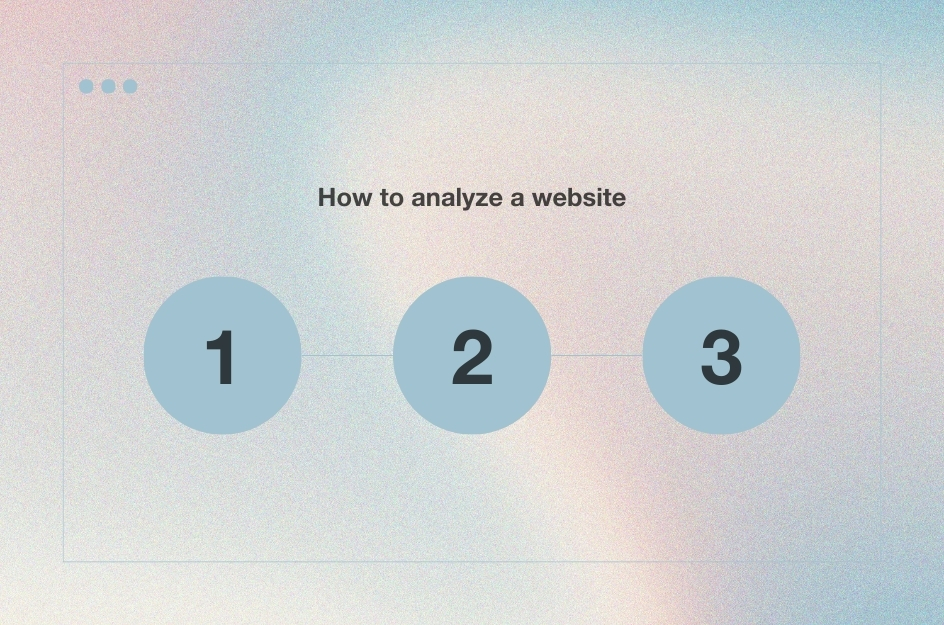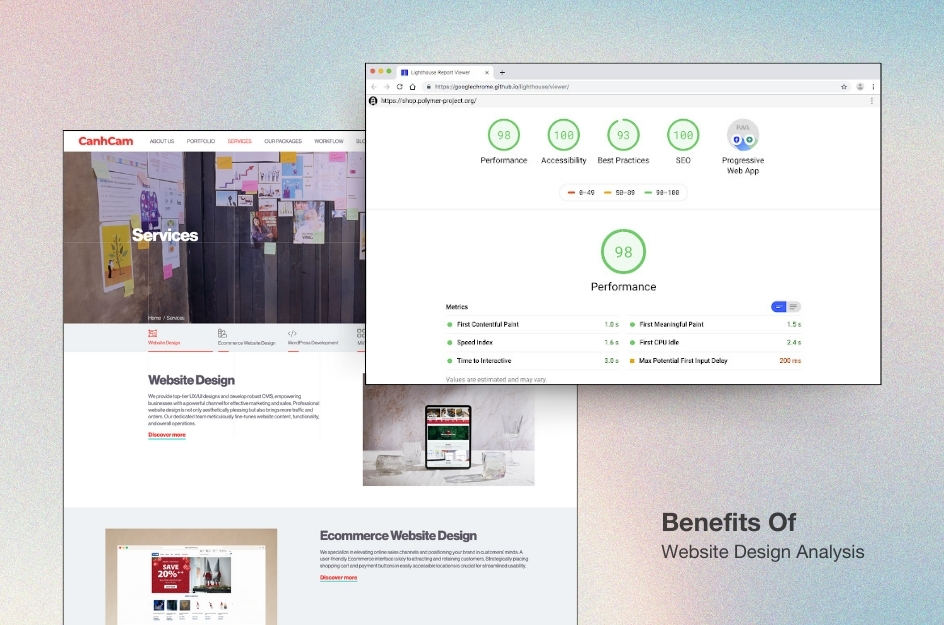Are you aiming to boost your online visibility and attract more visitors to your site? Evaluating your website's design might hold the solution to maximizing its effectiveness. Ensuring a favourable user experience is crucial for retaining potential customers on your site. Performing a thorough website analysis can help pinpoint any aspects that could hinder user engagement and deter individuals from interacting with your business.
Analyzing website design is a critical aspect of enhancing online presence and user experience. In today's digital landscape, where first impressions matter, the design of a website can make or break its success. Understanding the importance of analyzing website design allows businesses to stay competitive and relevant in the ever-evolving online market. So, let’s dive in and discover how to analyze website design with CanhCam.
What is Analysis for Website Design?
Website design analysis is the process of critically evaluating various aspects of a website's design to determine its effectiveness in achieving its objectives. It encompasses assessing factors such as visual appeal, navigation, usability, responsiveness, and overall user experience. Through that, businesses gain valuable insights into how their website is perceived and utilized by visitors, enabling them to make informed decisions to optimize its performance.
Understanding website design is essential for businesses looking to establish a strong online presence and achieve their objectives. By analyzing website design, businesses can uncover areas of improvement to enhance user engagement, increase conversions, and ultimately drive business growth.
How to Analyze a Website?
Are you interested in improving your website's performance and enhancing user experience? Analyzing website design is a crucial step in achieving your online goals. With its profound understanding and extensive experience, CanhCam will guide you through the steps to effectively analyze the design of your website.
Visit Our Services: Best Melbourne Web Design
This guide provides advice for maintaining your website to ensure it operates at its best performance. By following the insights provided here, you'll discover the most significant opportunities for enhancing its functionality.
Evaluate your technical and SEO basics
Start by conducting a thorough examination of your website's technical infrastructure and SEO factors. This includes considering aspects such as page loading speed, mobile responsiveness, URL structure, meta tags, keywords, and internal linking structure.
You can run technical checks with SEO platforms like Semrush, Moz, and Ahrefs. Technical issues can negatively impact user experience and your website's ranking on search engines. Utilize SEO analytics tools and Google Search Console to assess how you're ranking for important search terms in relevant positions.
Assess your website's performance on different devices and browsers
With the increasing diversity of devices and browsers used by internet users, it's crucial to ensure that your website functions optimally across all platforms. Use tools like Google Analytics to gather data on user behaviour and identify any discrepancies in performance across devices and browsers. Pay attention to metrics such as bounce rate, average session duration, and conversion rates to gauge the effectiveness of your website design on different platforms.

Conduct usability testing on your mobile site: Minor issues with your mobile user experience might not be immediately noticeable. If you notice notable disparities in conversions between your mobile and desktop versions, conduct usability testing to understand how users interact with your mobile site.
Reconnect with your target audience
Understanding your target audience is key to designing a website that resonates with their needs and preferences. Conduct market research to gather insights into your audience's demographics, psychographics, and online behaviour. Utilize surveys to pinpoint primary audience segments by querying visitors about their job titles, industry, or other demographic details.
Subsequently, merge these findings with website tracking data to gain deeper insights into your audience segments. Analyze data from various sources including customer surveys, social media interactions, and website analytics to uncover trends and patterns that can guide your website design choices.
Analyze your competitors
Analyzing your competitors' websites can provide valuable insights into industry best practices, emerging trends, and areas for improvement. Take note of design elements, content strategies, and user experience features that are effective on competitor websites. Identify opportunities to differentiate your website and offer unique value propositions that set you apart from the competition.
Gain insight into how customers navigate through your website
Use tools like heatmaps, click tracking, and session recordings to visualize user journeys and identify areas of friction or confusion. Analyze data on page views, time spent on a page, and conversion funnels to optimize your website's layout, navigation, and content for improved user engagement and conversion rates.
Observe and understand the user
It's essential to comprehend the motivations and uncertainties of users who drop off on certain pages. Similarly, for pages with high traffic, understanding users' interests and identifying their subsequent needs or desires is important. Certain pages on your website, such as the homepage, product pages, and checkout process, play a critical role in shaping the user experience and driving conversions.
Conduct usability testing sessions or surveys to gather feedback from users on these key pages. Pay attention to factors such as clarity of messaging, ease of navigation, and visual appeal to identify areas for improvement and optimization.
Why visitors are exiting the site?
Analyzing exit pages and abandonment rates can provide insights into points in the user journey where visitors are dropping off or disengaging from your website. Look for patterns or trends that may indicate usability issues, technical glitches, or content gaps that are driving users away. Addressing these issues can help reduce bounce rates and improve overall user retention and satisfaction.
Request feedback from users who have successfully converted
Reach out to users who have completed desired actions on your website, such as making a purchase or signing up for a newsletter. Solicit feedback on their experience, including what aspects of the website design they found helpful or hindering to their decision-making process. Use this feedback to identify areas of strength and opportunities for further optimization to enhance the overall conversion process.
Determine the next steps based on the final analysis
Synthesize the insights gathered from your analysis and prioritize actionable steps for website improvement. Develop a comprehensive action plan that outlines specific tasks, timelines, and responsible parties for implementing changes and enhancements to your website design. Regularly monitor progress and performance metrics to ensure that your website continues to evolve and adapt to the needs and preferences of your target audience.
Benefits of Website Analysis
Before delving into how to analyze a website, it's important to first recognize its benefits. If you're doing business online, website analysis is a crucial step to maintain visibility on search engine result pages. By understanding the nuances of website design, businesses can unlock a myriad of benefits.
Understanding visitor behaviour
By scrutinizing user interactions, such as click-through rates and bounce rates, businesses gain invaluable insights into what resonates with their audience. This knowledge empowers them to tailor their website to better meet user expectations, ultimately enhancing engagement and fostering customer loyalty.
Escalator the conversion rate
A website that performs well usually boasts a high conversion rate. To achieve this objective, it's essential to pinpoint the factors that impact the website's conversion rate. By identifying bottlenecks in the user journey, businesses can implement strategic design changes to streamline the path to conversion. Whether it's optimizing call-to-action buttons or simplifying checkout processes, every tweak aimed at improving user experience has the potential to translate into tangible results.
Assistance in measuring the effectiveness of a campaign
By tracking metrics such as traffic sources and referral paths, businesses can gauge the impact of their marketing efforts and allocate resources more efficiently. Whether it's evaluating the performance of a social media campaign or assessing the ROI of a PPC campaign, website analysis provides the data-driven insights needed to refine marketing strategies.
Identifying technical issues at the outset
Website analysis plays a pivotal role in initially detecting technical issues. From broken links to slow loading times, even minor glitches can detract from the overall user experience and hinder conversions. By regularly auditing website performance, businesses can promptly address any technical hiccups and ensure smooth sailing for visitors navigating their site.
Assist in the decision-making
Website analysis assists in decision-making by providing actionable data-driven insights. Whether it's deciding on website redesigns or prioritizing feature enhancements, having access to comprehensive analytics enables businesses to make informed decisions that drive growth and profitability.

Some tools for conducting website analysis
Having the appropriate tools is essential for effectively analyzing website design. Here are five essential tools for conducting a comprehensive website analysis:
Google PageSpeed Insights
This tool provides valuable data on a website's loading speed and performance across different devices. Google PageSpeed Insights is essential for gaining insights into your audience's browsing experience.
These tools enable you to pinpoint issues that could be contributing to slow loading times and to implement optimizations for enhanced website performance. Moreover, PageSpeed Insights provides recommendations for improving load times, such as reducing server response time and optimizing image sizes.
GTmetrix
GTmetrix provides detailed reports on various aspects of a website’s performance, including page loading times, total page size, and the number of requests made. With GTmetrix, you can identify bottlenecks in your website's loading process and implement optimizations to improve overall performance. The tool also offers recommendations for optimizing elements such as CSS and JavaScript files to further enhance load times.
Marketing CloudFX
MarketingCloudFX is a comprehensive platform that offers a range of tools for website analysis. From tracking user behaviour to monitoring website performance, this tool provides valuable insights into your website's design effectiveness. With features such as heat mapping and conversion tracking, MarketingCloudFX helps you understand how visitors interact with your site, allowing you to make informed decisions to optimize your design.

Google Analytics
Google Analytics is a staple tool for website analysis, offering a wealth of data on user engagement, traffic sources, and more. By diving into metrics such as bounce rate, session duration, and page views, you can gain valuable insights into the effectiveness of your website design. With its intuitive interface and customizable reports, Google Analytics empowers you to track key performance indicators and identify areas for improvement in your website's design.
SEO Checker
SEO Checker is a powerful tool specifically designed to assess the SEO-friendliness of your website. While its primary focus is on search engine optimization, SEO Checker also provides valuable insights into website design elements that impact SEO performance. From analyzing metadata to evaluating site structure, this tool helps you identify design flaws that may be hindering your search engine rankings. By addressing these issues, you can enhance both the visibility and usability of your website.
Frequently Asked Questions (FAQs)
1. How can I measure the SEO performance of a certain website?
Consider the data from your organic search traffic, keyword rankings and CTRs through Google Search Console or SEMrush. Review on-page SEO factors: meta tags, headings, and quality content.
2. What is A/B testing and how can it be useful in website analysis?
A/B testing is the practice of exposing visitors to different versions of a web page and then checking which one has a better conversion rate or user engagement. Besides, it helps us to develop.
Conclusion
Website design analysis serves as a cornerstone of digital success, empowering you to create websites that not only look great but also perform optimally and resonate with your target audience. By prioritizing continuous analysis and refinement, you can ensure that your website remains a dynamic and effective tool for achieving your online objectives.

